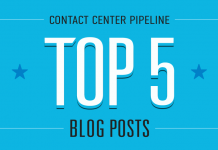
We know that agent turnover—particularly among entry-level staff—is still the No. 1 challenge for contact centers. As Matt Stevenson, Mercer Partner and Leader of Mercer’s Workforce Strategy and Analytics group, pointed out, the growth of the on-demand economy will only drive up turnover rates.
One way to combat higher turnover in the center due to the availability of on-demand work options is to make the agent’s job more flexible. “This is where work-at-home comes in, because agents can be that much more flexible if they don’t have to commute to their jobs,” Stevenson says.
Contact centers also can make a considerable dent in new-hire turnover by refining the hiring and onboarding process to ensure that the people they bring on are a good fit for the job, the company culture and their customer base. How? Top-performer modeling can help. This process identifies the characteristics that make the top 5% to 10% of your staff successful, and uses those common traits to guide the selection and on boarding process, according to Service Agility’s Jay Minnucci. He lists several attributes to include in your model, such as: months of prior phone experience, length and/or type of customer service experience; scores on the phone interview; education level; extracurricular activities; prior leadership experience; answers to behavior questions in the interview; and referrals from current staff.
Minnucci adds that, while the most common use of top-performer modeling is to help select the best candidates for the agent position, it’s also an excellent way to identify the best onboarding processes.
Case in point, Vivint Smart Home. Vivint’s customer care leadership team first looked to their data to ensure that their hiring strategy identified the right individuals for the job. The team began with a profile of top-performing agents. They then analyzed the 2,000 most recent hires to develop an employee lifecycle plan to ensure that agents are performing optimally for their level of training and time on the job. Each new-hire’s performance is tracked weekly, and those who fall below the standard are provided with additional coaching. The process has improved new agents’ time to productivity by seven weeks, and new-hire satisfaction is higher because agents are more confident in their job knowledge.
Another way to minimize the risk of a bad hire is to ask your current staff for referrals. Your agents understand the pros and cons of the job, and they know whether the friends they refer would be well-suited to the work. According to Robert Half’s Small and Midsize Business Hiring survey, 58% of respondents said that the best new-hires come from referrals, including employees, friends, recruiters and others in their network.
Providing a clear, honest job preview will help to weed out those who are likely to leave before making a significant investment in the candidate’s training. Including time on the phones jacked in with a senior agent as part of the screening process will give candidates a better understanding of what the job entails.
Pairing new-hires with senior agents can provide an all-important support system during the orientation and training stage. At Carbonite, every new-hire is assigned a mentor—a top-performing senior agent who sits with the new-hire to review training checklists and share best practices. The new-hire will shadow his mentor until he feels comfortable handling calls on his own—and both must agree that the new-hire is ready.
With sales agents, it can be particularly difficult to retain new-hires during the first few months of employment because they’re typically ineligible for incentives, says Beth Ann Finis, a Principal in Mercer’s Talent Information Solutions business. “Offering an incentive plan that bridges the gap so new sales agents don’t have to wait until they’re fully trained and operating at full capacity to be eligible may help to retain agents,” she says. “It provides the agent with some form of guaranteed pay early on, until they reach the sales floor and are able to earn sales incentives.”
Early in the employee lifecycle, companies can speed up the onboarding process by using gamification tools to reinforce certain behaviors taught in new-hire training, such as schedule adherence, or by engaging new-hires in learning with a series of challenges that, once accomplished, allows them to unlock new levels of training.
Finally, recognition can have a strong impact on a new-hire’s level of engagement. Recognizing agents in the early days of employment gives them a sense of belonging, and encourages them to perform higher. According to Mercer’s 2016 U.S. Contact Center Survey, 66% of companies are utilizing formal non-cash recognition to reward team members and reduce turnover. The most common are trophies, plaques, gift certificates and award checks, says Finis. “Public recognition can be very powerful and meaningful,” she says, adding that recognition which is visible, such as plaques and trophies that peers in the center and in other departments can see, is highly effective.
Download a PDF of the full article.



